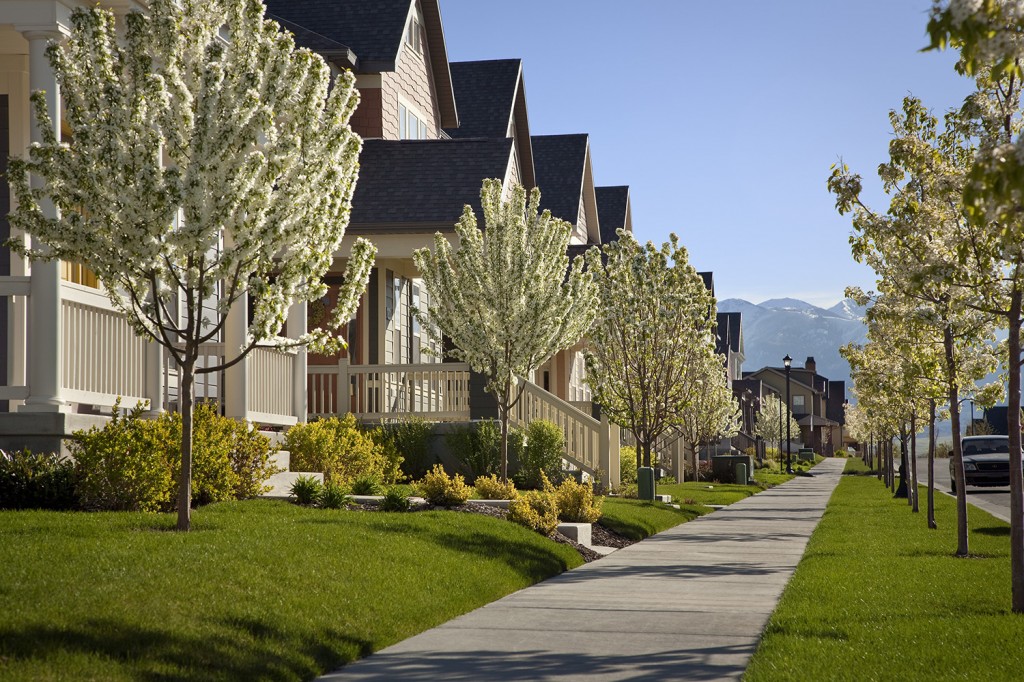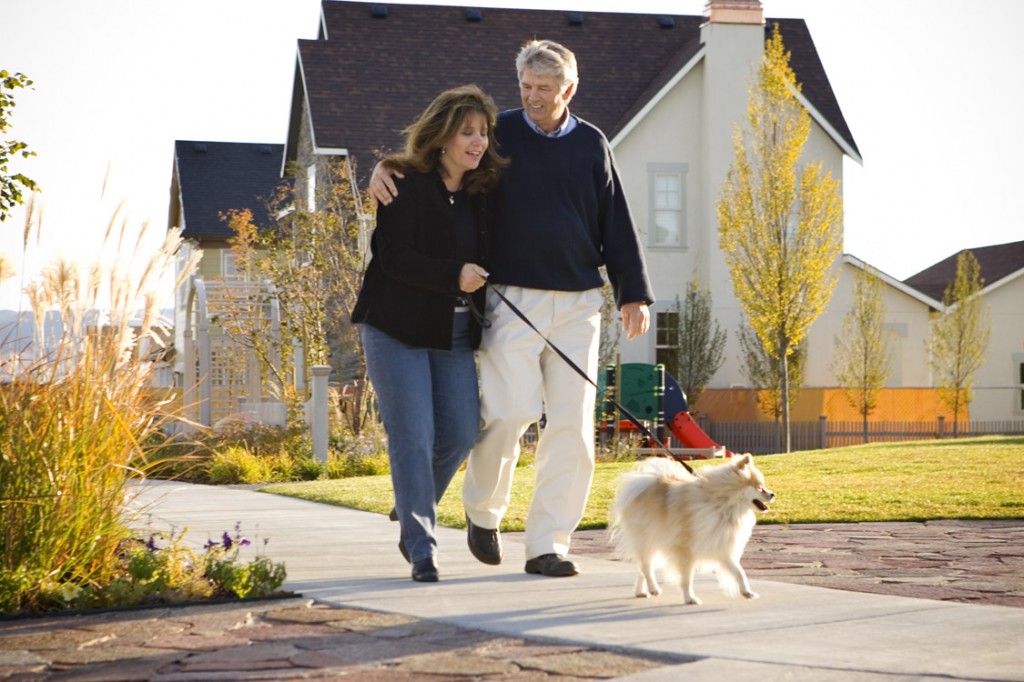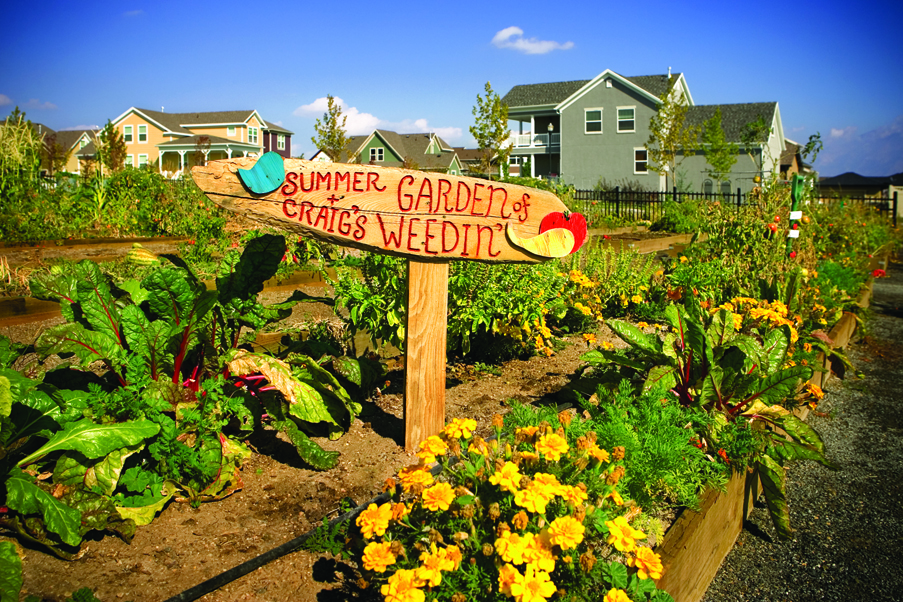In Daybreak, “close to everything” is more than a slogan—it’s a design principle. Streets, sidewalks, parks, schools, shops, and transit were placed so more of life happens within a short stroll or bike ride.
TL;DR: Why Walkability Matters
- Convenience: Everyday errands, coffee runs, and park time fit between meetings.
- Health: Walking becomes the default, not a chore.
- Connection: You see neighbors more often, which builds a friendlier community.
- Safety: Predictable traffic, slower speeds, and visible crossings encourage walking and biking.
- Sustainability: Fewer short car trips means cleaner air and calmer streets.
- Value: Walk-to amenities and transit access add long‑term appeal.

The 5‑Minute Rule
Daybreak uses a simple idea: most daily needs should be reachable within a five‑minute walk. Consequently, villages include pocket parks, schools, paths, and gathering places placed in close proximity. As a result, walking feels natural—because it is.
“Designing for short trips changes everything—it reclaims time and builds routine movement into the day.”
To see how it plays out, start at your front door, choose a direction, and time your stroll to a park, trail connection, or local café.
Trails, Parks & Water
Daybreak’s connected trail network links neighborhoods to parks, plazas, and waterfronts. For variety, loop around Oquirrh Lake or explore the channels of The Watercourse. Because routes interconnect, you can mix short walks with longer weekend rides.
- Planned shade trees and seating make walking pleasant in every season.
- Traffic‑calmed streets shorten crossing distances and slow vehicle speeds.
- Wayfinding helps visitors navigate between villages and amenities.
Everyday Play Within Reach
Since the nearest park is usually just a few minutes away, playtime simply happens more often. Meanwhile, spontaneous meet‑ups become easier when kids’ friends live a block or two over.
Walk to School
Daybreak deliberately places schools inside neighborhoods, so students can reach classrooms on foot or by bike. According to a University of Utah snapshot cited in earlier Daybreak materials, over 70% of students walk to school at least once a week. In turn, fewer idling cars in drop‑off lines means cleaner air and a calmer morning rhythm.
Nearby options include Daybreak Elementary, Eastlake Elementary, and Early Light Academy, with secondary schools a short drive away. Many families also organize “walking school buses” for even more peace of mind.
After‑School Convenience
Because school, parks, and home are close together, clubs and practices fit more easily into family schedules. Moreover, parents can volunteer or attend events without a long commute.
TRAX & Regional Access
For trips beyond the neighborhood, Daybreak connects to the region via TRAX light rail. With multiple stations in the community, residents can reach downtown Salt Lake, the university, or the airport area with fewer transfers. As a bonus, it’s easy to combine a short walk with transit—no parking hunt required.
Bike‑Friendly by Design
Bike lanes and shared‑use paths weave through the villages, which makes errands or recreation rides straightforward. In addition, low‑stress streets invite new riders to build confidence step by step.
Shops & Dining
Walkability shines when cafés and conveniences are nearby. In Daybreak, you can stroll to SoDa Row or head to Downtown Daybreak for restaurants, services, and seasonal events. Because these hubs sit inside the community fabric, quick errands become part of your daily steps.
Events & Everyday Culture
Concerts, markets, and community gatherings pop up throughout the year. Consequently, you can walk to an evening show, stop for dessert, and be home in minutes—no freeway required.
Health & Well‑Being
Simply put, a walkable routine builds movement into your day. Even brief, frequent walks support heart health and stress relief. Likewise, kids gain independence and daily exercise as they navigate short trips with family or friends.
Safety & Comfort
Daybreak’s street network and crossings aim to make walking feel predictable. Shorter blocks, curb extensions, and visibility at corners help drivers and pedestrians see each other sooner, while tree‑lined sidewalks provide separation from traffic.
Home Value & Long‑Term Demand
Homes in walkable neighborhoods tend to remain in demand because daily convenience never goes out of style. In practical terms, proximity to parks, schools, trails, and transit adds a durable layer of appeal for a wide range of buyers and renters.
Sustainability & Air Quality
When more errands happen on foot, neighborhoods enjoy fewer short car trips—the least efficient kind. Consequently, walkability supports better air quality and a calmer street experience, especially during winter inversion season.
Get Started: Try a 5‑Minute Loop
- Pick a starting point—your front door or a favorite park bench.
- Walk five minutes in any direction; note what you can reach easily.
- Map a daily errand (coffee, a playground stop, or school pickup) on foot.
- Save longer trips for weekends and explore a new trail segment each time.
New to the area? Begin at the Daybreak Info Studio at the Cove House for maps and tips, or check our Trails & Paths page.
Come see for yourself why more than 11,000 residents have called Daybreak home for the last 10 years.

